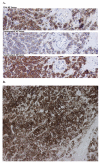Next generation sequencing of prostate cancer from a patient identifies a deficiency of methylthioadenosine phosphorylase, an exploitable tumor target
- PMID: 22252602
- PMCID: PMC3691697
- DOI: 10.1158/1535-7163.MCT-11-0826
Next generation sequencing of prostate cancer from a patient identifies a deficiency of methylthioadenosine phosphorylase, an exploitable tumor target
Abstract
Castrate-resistant prostate cancer (CRPC) and neuroendocrine carcinoma of the prostate are invariably fatal diseases for which only palliative therapies exist. As part of a prostate tumor sequencing program, a patient tumor was analyzed using Illumina genome sequencing and a matched renal capsule tumor xenograft was generated. Both tumor and xenograft had a homozygous 9p21 deletion spanning the MTAP, CDKN2, and ARF genes. It is rare for this deletion to occur in primary prostate tumors, yet approximately 10% express decreased levels of methylthioadenosine phosphorylase (MTAP) mRNA. Decreased MTAP expression is a prognosticator for poor outcome. Moreover, it seems that this deletion is more common in CRPC than in primary prostate cancer. We show for the first time that treatment with methylthioadenosine and high dose 6-thioguanine causes marked inhibition of a patient-derived neuroendocrine xenograft growth while protecting the host from 6-thioguanine toxicity. This therapeutic approach can be applied to other MTAP-deficient human cancers as deletion or hypermethylation of the MTAP gene occurs in a broad spectrum of tumors at high frequency. The combination of genome sequencing and patient-derived xenografts can identify candidate therapeutic agents and evaluate them for personalized oncology.
Figures




References
-
- di Sant’Agnese PA. Neuroendocrine differentiation in carcinoma of the prostate. Diagnostic, prognostic, and therapeutic implications. Cancer. 1992;70:254–68. - PubMed
-
- Abbas F, Civantos F, Benedetto P, Soloway MS. Small cell carcinoma of the bladder and prostate. Urology. 1995;46:617–30. - PubMed
-
- Randolph TL, Amin MB, Ro JY, Ayala AG. Histologic variants of adenocarcinoma and other carcinomas of prostate: pathologic criteria and clinical significance. Mod Pathol. 1997;10:612–29. - PubMed
-
- Erasmus CE, Verhagen WI, Wauters CA, van Lindert EJ. Brain metastasis from prostate small cell carcinoma: not to be neglected. Can J Neurol Sci. 2002;29:375–7. - PubMed
-
- Miyoshi Y, Uemura H, Kitami K, Satomi Y, Kubota Y, Hosaka M. Neuroendocrine differentiated small cell carcinoma presenting as recurrent prostate cancer after androgen deprivation therapy. BJU Int. 2001;88:982–3. - PubMed
Publication types
MeSH terms
Substances
Grants and funding
LinkOut - more resources
Full Text Sources
Other Literature Sources
Medical
Research Materials
Miscellaneous

